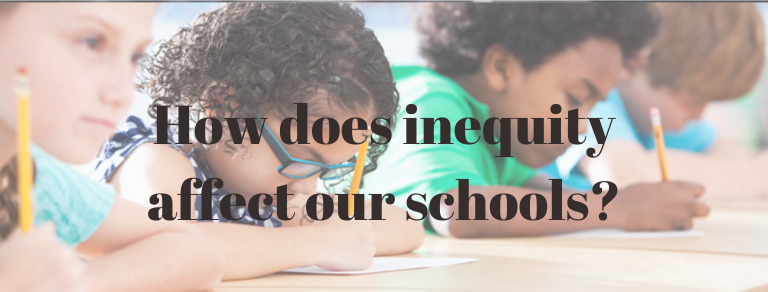Although inequity can affect all minority groups, we focused our efforts on the impacts of racial inequity to help educators understand the systemic ways implicit racial biases can contribute to the educational opportunity gap for children of color. We hope this research, and the resources we provide, will guide educators into establishing school-wide interventions and practices that aim to improve equity and reduce racial disparities and disproportionality in our schools.
Racial inequity in our schools can affect students of color in many ways, including discipline referrals, academic access, treatment by teachers, and more. The research below has been divided up by topic.
Discipline
Racial disproportionality in discipline referrals, suspensions, and expulsions is a problem that many schools in the U.S. continue to face, even in pre-schools. This disproportionality in discipline can lead to loss of critical instruction time, create a feeling of exclusion for students, and contribute to the school-to-prison pipeline.
| Topic Area | Research |
| Referrals, Suspensions, and Expulsion Rates |
|
| Subjectivity and Implicit Bias in Referrals |
|
| Zero Tolerance Policies vs. Restorative Justice |
|
Academic Achievement/Opportunity Gap
Racial disproportionality in academic achievement, now called the “opportunity gap,” have also been widely researched and documented. Disproportionality in suspensions have been linked to differences in academic achievement for children of color due to loss of instruction time. Other academic policies such as course/academic tracking and stereotypes/implicit bias from educators also disproportionately affects students of color.
| Topic Area | Research |
| Discipline Effects on Academics |
|
| Tracking and Other Obstacles |
|
Teacher Expectations & Support
Related to academic success, differences have also been observed in teacher expectations of children of color and how they provide support. Oftentimes, these disparities are due to implicit biases and microaggressions that result in students feeling a lack of belonging, lack of adult support, and low expectations. Understanding the systemic racism in the education system, building relationships with students, families, and the community, and creating safe spaces to discuss race have been shown to be effective in ensuring culturally responsive teaching methods.
| Topic Area | Research |
| Implicit Bias/Microaggressions in Teacher Expectations |
|
| Positive Teaching Methods |
|
References
Aldridge, S. (2018). Criminalization and discrimination in schools: The effects of zero tolerance policies on the school-to-prison pipeline for black girls. Aisthesis, (9), 1-7.
Allen, A., Scott, L. M., & Lewis, C. W. (2013). Racial microaggressions and African American and Hispanic Students in urban schools: A call for culturally affirming education. Interdisciplinary Journal of Teaching and Learning, 3(2), 117–129.
Balfanz, R., Byrnes, V., & Fox, J. (2014). Sent home and put off-track: The antecedents, disproportionalities, and consequences of being suspended in the ninth grade. Journal of Applied Research on Children: Informing Policy for Children at Risk, 5(2), 17-30.
Blaisdell, B. (2016). Schools as racial spaces: Understanding and resisting structural racism. International Journal of Qualitative Studies in Education, 29(2), 248-272.
Bottiani, J., Bradshaw, C., & Mendelson, T. (2016). A multivariate examination of racial disparities in high school discipline: Black and white adolescents’ perceived equity, school belonging, and adjustment problems. Journal of Educational Psychology, 1-14.
Bottiani, J., Bradshaw, C., Mendelson, T. (2016). Inequality in black and white high school students’ perceptions of school support: An examination of race in context. Journal of Youth and Adolescence, 45, 1176-1191.
Byrd, C. (2016). Does culturally relevant teaching work? An examination from student perspectives. Student Diversity, 1-10.
DeMatthews, D. (2016). Effective leadership is not enough: Critical approaches to closing the racial discipline gap. The Clearing House: A Journal of Educational Strategies, Issues, and Ideas, 89(1), 7-13.
Girvan, E., Cion, C., McIntosh, K., & Smolkowski, K. (2016). The relative contribution of subjective office referrals to racial disproportionality in school discipline. School Psychology Quarterly, 32(3), 392-404.
Gordon, N. (2018). Disproportionality in student discipline: Connecting policy to research. Brookings. Retrieved from: https://www.brookings.edu/research/disproportionality-in-student-discipline-connecting-policy-to-research/
Gregory, A., Skiba, R. J., & Noguera, P. A. (2010). The achievement gap and the discipline gap: Two sides of the same coin? Educational Researcher, 39, 59-68. doi: 10.3102/0013189×09357621
Johnson-Ahorlu, R. (2012). The academic opportunity gap: How racism and stereotypes disrupt the education of African American undergraduates. Race Ethnicity and Education, 15(5), 633-652.
Losen, D. J., & Whitaker, A. (2018). 11 million days lost, race, discipline, and safety at U.S. public schools. Center for Civil Rights Remedies of UCLA’s Civil Rights Project and The American Civil Liberties Union of Southern California.
Morris, E. & Perry, B. (2016). The punishment gap: School suspension and racial disparities in achievement. Social Problems, 63, 68-86.
Schiff, M.(2018). Can restorative justice disrupt the “school-to-prison pipeline?” Contemporary Justice Review, 21(2), 121-139.
Skiba, R. J., Horner, R. H., Chung, C. G., Rausch, M. K., May, S. L., & Tobin, T. (2011). Race is not neutral: A national investigation of African American and Latino disproportionality in school discipline. School Psychology Review, 40, 85–107.
Sleeter, C. (2016). Wrestling with problematics of whiteness in teacher education. International Journal of Qualitative Studies in Education, 29(8), 1065-1068.
Smolkowski, K., Girvan, E. J., McIntosh, K., Nese, R. N. T., & Horner, R. H. (2016). Vulnerable decision points in school discipline: Comparison of discipline for African American compared to White students in elementary schools. Behavioral Disorders, 41, 178-195.
Tyson, K. (2013). Tracking, segregation, and the opportunity gap: What we know and why it matters. Closing the Opportunity Gap: What America Must Do to Give Every Child an Even Chance. 169-249. New York, NY: Oxford University Press.

